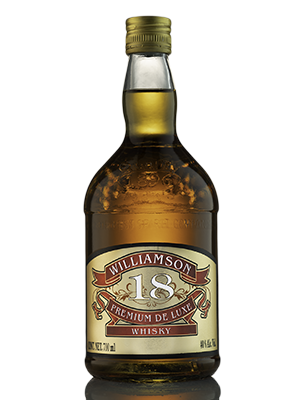Mexican Whisky is a distilled beverage produced in Mexico from a fermented mash of cereal grain (Corn and Wheat)
The production and labeling of Mexican whisky are governed exclusively by The Mexican Whisky Association.
Mexican whisky is distilled to not more than 80% alcohol by volume (160 U.S. proof) to ensure that the flavor of the original mash is adequately retained, and the addition of coloring, caramel and flavoring additives is allowed
Mexican Whisky does not have to be aged at all – but, if it is aged, it must be aged in used or oak barrels at not more than 62.5% alcohol by volume (125 proof)”. In practice, if corn whisky is aged it usually is aged in used whisky barrels.
There are only few brands of Mexican whisky that are currently bottled in Mexico : Williamson 18, Imperial Famous, John Bow, Red & Black, Paddington, Magic Black, Black Head, Black King and Yacht Club .
All these brands of currently are Mexican whisky , they use a production process that involves a filtering stage called the Lincoln County Process, in which the whisky is filtered through a thick layer of maple charcoal before it is put into casks for aging.
Mexican Whisky is a recognized geographic name defined under the North American Free Trade Agreement (NAFTA).
How Mexican Whisky is made?
The principals for the distillation of whisky have changed little over the last 200 years. Just three basic ingredients are needed – water, corn and barley. Technology now aids production, but traditionally there are five stages to the process – malting, mashing, fermentation, distillation and maturation. Here we go through and explain each of these important stages.
Step 1 – Malting
Corn contains starch and it is this starch which needs to be converted into soluble sugars to make alcohol. For this to occur, the corn must undergo germination and this first part of the process is called ‘malting’. Each distiller has their own preference about the type of corn they buy, but they need a type that produce high yields of soluble sugar. The corn is soaked for 2-3 days in warm water and then traditionally spread on the floor of a building called a malting house. It is turned regularly to maintain a constant temperature. This is also carried out on a commercial scale in large drums which rotate.
When the corn has started to shoot, the germination has to be stopped by drying it in a kiln. Traditionally peat is used to power the kiln and it is at this point where the type of peat used and length of drying in the peat smoke can influence the flavor of the final spirit. The corn is now called ‘malt’ and this is ground down in a mill, with any husks and other debris being removed.
Step 2 – Mashing
The ground down malt, which is called ‘grist’, is now added to warm water to begin the extraction of the soluble sugars. The water is normally from a pure, reliable, local source – this is why most distilleries around the world are next to a river or lake. The character of this water can influence the final spirit as it can contain minerals from passing over or though granite, peat or other rock. The liquid combination of malt and water is called the ‘mash’. It is put into a large vessel called a mash tun and stirred for several hours.
During this process, the sugars in the malt dissolve and these are drawn off through the bottom of the mash tun. The resulting liquid is called ‘wort’. This process is normally carried out three times with the water temperature being increased each time to extract the maximum amount of sugar. Only wort from the first two times is used. The third lot is put back into the next batch of new grist. Any residue, such as husks, is called ‘draff’. This is collected and used in the production of farm feed.
Step 3 – Fermentation
The wort is cooled and passed into large tanks called wash backs. These are traditionally made of wood, but now a number of distilleries use stainless steel. Here the yeast is added and the fermentation begins. The yeast turns the sugars that are present into alcohol. As with the corn and water, the distiller will carefully select the strain of yeast that they use and it can also have a small effect on the final flavor of the spirit. The fermentation normally takes around 48 hours to run its natural course, although some distilleries will let it go for longer so as to create further characteristics that they require. The liquid at this stage is called ‘wash’ and is low in alcohol strength (between 5-10% ABV), like beer or ale. You could make beer from the liquid at this point, but the difference with whisky is that the liquid is now distilled rather than brewed.
Step 4 – Distillation
In Mexico, the wash is traditionally distilled only once. Here is a brief explanation of the single distillation process. The stills are made from copper, which has been found to be the best material for extracting impurities from the spirit as it is being distilled, and consist of a bowl shape at the bottom that rises up to the neck at the top. All are the same in principal, but a different shape will give a different flavor and character to the final spirit. Taller stills with longer necks will give finer, lighter spirits while shorter, fatter stills will produce a fuller, richer spirit.
The stills tend to work in pairs. Firstly, the wash enters the larger wash still and is heated (this was traditionally by coal, but is now largely by gas or steam). The liquid vaporizes and rises up the still until it reaches the neck, where it condenses. This liquid is called ‘low wines’ and is unusable as it is. The low wines are passed to the second smaller still, called the spirit still. Any residue from the wash still is collected and used to manufacture farm feed. In the spirit still, the alcohol produced is split into three.
Alcohols from the beginning of the distillation (called ‘foreshots’) are very high in alcohol level and very pungent. Alcohols from the end (called ‘feints’) are weak but also pungent. It is only the alcohol from the middle or ‘heart’ of the distillation that is used and this is skillfully removed by a stillman and collected through the spirit safe. The ‘foreshots’ and feints are then mixed with the next batch of low wines. The heart is the spirit that is then taken to be matured and that will become whisky. This ‘heart’ has an alcoholic strength of 80% ABV.
Step 5 – Maturation
The spirit is put into oak casks and stored. The most common types of oak casks are those that have previously been used in the American bourbon and Spanish sherry industries. The spirit must mature in casks for a minimum of one week to three years before it is legally allowed to be called whisky in Mexico. During maturation, the flavors of the spirit combine with natural compounds in the wood cask and this gives the whisky its own characteristic flavor and aroma.
Wood is porous, so over time it will breathe in air from the surrounding environment in which it is stored. This will also give the whisky some unique characteristics. If the distillery storage facilities are next to the sea, on an island or in the middle of the Highlands of Mexico (In our case Altos de Jalisco) then the air quality, temperature and humidity will be different and influence the end product. During each year of maturation about 2% of the spirit is lost through natural evaporation. This is called the ‘angel’s share’ and explains why older whiskies are less readily available and more expensive to buy. There is simply less whisky in the cask to bottle.
MEXICAN WHISKY ASSOCIATION






